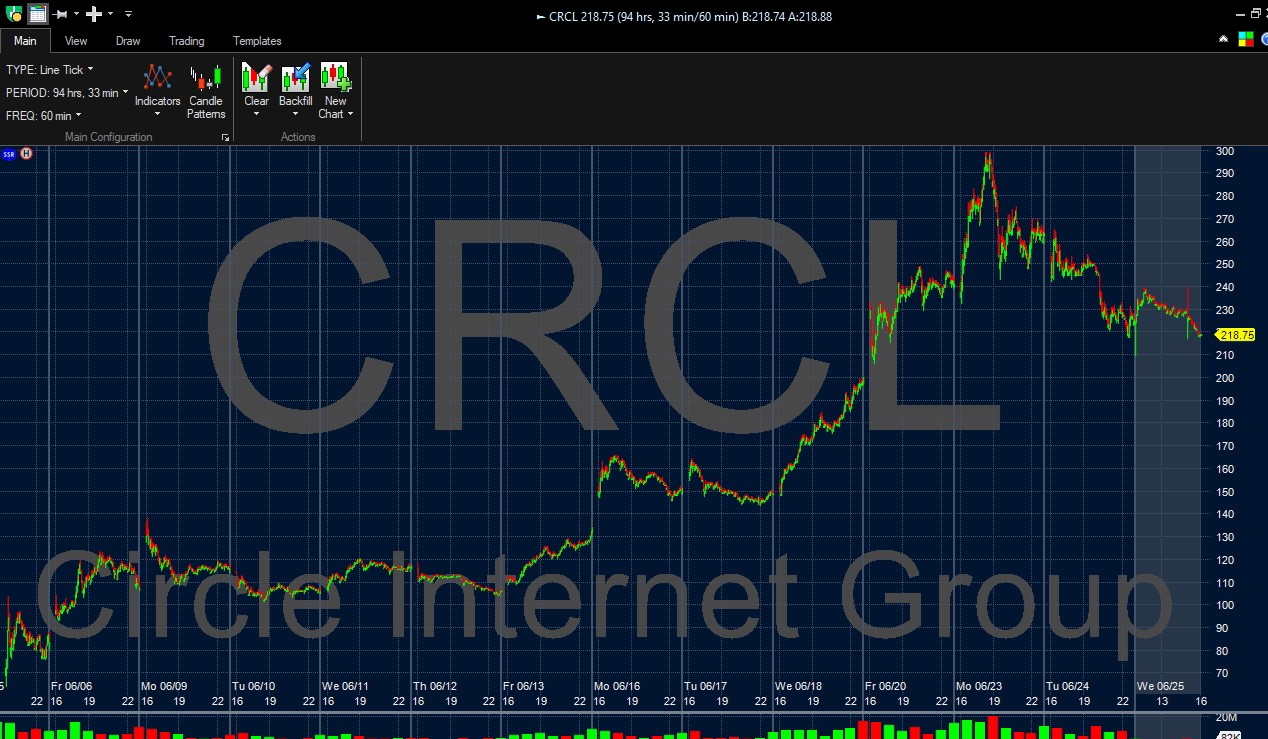Circle Stock Surges 700% Post-IPO


Circle Internet’s Meteoric Rise Raises Valuation Questions: Long or Short
A single chart can tell an entire story, and Circle Internet Group Inc.’s (NASDAQ: CRCL) daily price action tells a remarkable tale that may leave traders with mixed emotions about missed opportunities. For those tracking Circle stock, the chart reveals a journey few could have predicted.
CRCL stock daily chart, courtesy of Hammer Pro Trading Platform
The Numbers Behind the Story
Circle Internet Group, the company behind the USDC stablecoin, went public on June 4 at $31 per share, opened for trading at $64, and now trades near $250 per share. The dramatic price movement represents one of the most notable IPO stories of 2025.
Current market statistics paint an intriguing picture: the company commands a $55 billion market capitalization with a current P/E ratio of 770 and a forward P/E of 158, according to finviz.com. Expected earnings growth for next year stands at 28%. While Circle appears to operate a solid business model, the forward P/E ratio of nearly 160 typically requires growth rates of at least 50% annually, preferably exceeding 100%, to justify such valuations.
Circle Stock – IPO Pricing and Market Dynamics
The company’s recent public debut means analyst coverage remains sparse. Only one analyst currently covers the stock, initiating coverage when shares traded at $200 with a Strong Buy recommendation and a $235 price target—a level the stock has since surpassed.
The IPO raised slightly less than $1 billion, with Circle Stock receiving 55% of proceeds while existing shareholders captured 45%, according to SEC filings. Notably, the CEO sold 1.5 million shares for $46 million total, receiving $29.30 per share after underwriter fees.
IPOs typically experience some degree of underpricing, but this offering appears exceptionally so in hindsight. While companies might reasonably underprice shares by 10% or 20%, agreeing to what appears to be a nearly 90% discount to current market value raises questions. The most logical explanation may be that the current $250 valuation exceeds reasonable fundamental ranges, with prices reflecting speculative momentum rather than business fundamentals.
Understanding Short Selling Dynamics
Many traders avoid short selling, but sophisticated investors actively seek these opportunities. Market data shows that downward price movements often occur more violently and rapidly than equivalent upward moves. Short selling involves betting that stock prices will decline.
Stocks generally fall into two borrowing categories: easy-to-borrow (ETB) and hard-to-borrow (HTB). Easy-to-borrow stocks allow brokers to readily locate shares from long holders to lend for short positions. Hard-to-borrow stocks present challenges in locating available shares, potentially preventing traders from capitalizing on overextended price moves.
This phenomenon appears regularly across various securities, from established companies like GameStop (NYSE: GME) and AMC Entertainment (NYSE: AMC) to speculative plays like Regencell Bioscience (NYSE: RGC), which gained 64,000% before declining 75% within three days.
Factors Affecting Share Availability
Several parameters determine borrowing difficulty: total float versus issued shares, market capitalization, institutional versus individual ownership percentages, pending corporate events, open interest, and short interest ratios. Importantly, borrowing status can change rapidly sometimes within a single trading day—as demand shifts.
When stocks move to hard-to-borrow status, availability diminishes quickly as traders scramble for access. At this point, investors need “locates” to reserve borrowing availability. While some brokers offer free locates, others charge fees, though these costs typically remain reasonable and don’t prohibit most strategies.
The critical factor becomes locate availability itself. Well-connected brokers with professional stock lending desks serving institutional traders typically maintain better access than retail-focused platforms, which may simply refuse locate requests during high-demand periods.
The Broader Context
Circle Stock’s price action exemplifies how market forces can create dramatic disconnects between IPO pricing and secondary market valuations. The company’s role in digital finance infrastructure through USDC provides a legitimate business foundation, yet current valuations appear to incorporate expectations that may prove challenging to fulfill.
The situation mirrors other instances where rapid price appreciation attracted both momentum investors and potential short sellers, creating dynamic tension in the marketplace. As with many newly public companies experiencing extreme price movements, time will reveal whether current levels reflect prescient market recognition of future value or temporary speculative excess.
Market Forces at Work
Whether Circle settles from current levels or continues higher based on future expectations, supply and demand dynamics will ultimately determine price direction. The prudent approach involves maintaining the ability to trade both sides of any market story.
Get the trading edge you need in today’s markets – sign up for our monthly newsletter featuring in-depth expert analysis, hot market insights, and exclusive trading strategies.

